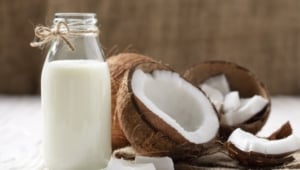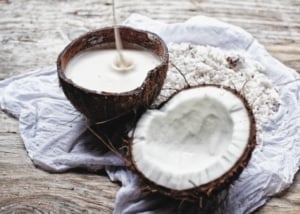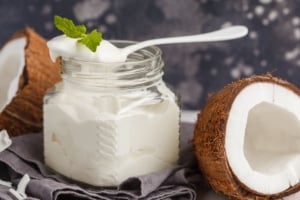Coconut Milk: 6 Health Benefits & 6 Tips for Using

In Asian cuisine, coconut milk is part of numerous recipes. In the USA the delicious cow’s milk alternative can be found in many kitchen cupboards, too. A pumpkin soup in winter or a red lentil soup with coconut milk in spring can bring an Asian vacation feeling to your home.
You’ve almost certainly used or consumed coconut milk without knowing it. It’s not only included in numerous dishes, but also in cosmetic products.
What Coconut Milk is

What coconut milk is
Coconut milk obviously comes from the coconut, which grows on coconut palms (Cocos nucifera). In addition to coconut milk, coconut cream, coconut oil, and coconut water can also be produced from the coconut. Coconut milk consists of a large portion of water, some sugar, and light carbohydrates.
Coconut milk contains a number of healthy minerals and vitamins. In addition to low calories, its properties include, above all, that it contains healthy fat and very little cholesterol.
The properties of coconut milk at a glance:
- Low in fat
- Low in calories
- Low in cholesterol
Coconut milk has uses beyond cooking and baking in the kitchen. It helps against bacteria, fungal diseases and viruses to maintain your health.
What Coconut Milk Looks Like
For many, coconut milk has become a vegan substitute for cow’s milk. It can be used in cereal for breakfast, in a smoothie in the afternoon, or in a creamy vegetable soup in the evening.
It consists of a white creamy substance made from coconut meat and water. Its aroma is fruity and nutty. In tropical countries such as Central and South America and Asia, coconut is a staple food. Sauces, rice dishes and desserts made from coconut milk are served in these areas.
How Coconut Milk is Made

How coconut milk is made
Coconut milk is made from the white meat of the coconut. This process can be done manually as well as with a machine and modern technology. Once the coconut flesh is removed, it can be ground.
The next step is to squeeze the ground coconut meat through a cotton cloth or press. This produces white, thick coconut milk. Typically, this liquid would then be mixed with water and put on the market in this form.
The Origin of Coconut Milk
The coconut palm is a tropical palm plant. It can grow up to 30 meters high and bear several coconuts. When they are ripe, they fall to the ground or are harvested by locals.
Coconut palms have been grown and cultivated for as long as 3,000 years. For the palms to thrive, they need moist and loose soil. They grow mainly in tropical countries such as India, Indonesia, Sri Lanka and the Philippines.
Differences between Coconut Milk, Coconut Cream, Coconut Oil and Coconut Water
The coconut milk is obtained from coconut meat. The inside of the coconut also contains fresh coconut water. It tastes slightly sweet and is very refreshing in summer.
We can obtain various products from the coconut:
- Coconut water
- Coconut oil
- Coconut milk
- Coconut cream
- Coconut snacks (e.g. coconut strips)
Coconut Water

Coconut water
Fresh coconut water is sold in markets in tropical countries. For this purpose, a small part of the coconut is broken open. By inserting a straw, one can then drink fresh coconut water. This fresh, tropical drink contains few calories, making it a good alternative to sugared thirst quenchers.
Like coconut milk, coconut water also has important minerals to maintain bone structure (for example: calcium and magnesium).
Coconut Oil
Coconut oil is a great alternative to conventional oil because it has fewer calories. It is also easy to digest and can be used in many dishes and baking recipes. Coconut oil is usually solid, but becomes liquid at warm temperatures.
The medium-chain fatty acids in coconut oil are effective against bacteria and viruses. This is true for both internal and external use.
If you have an open wound, you can use coconut oil for it as well. It has an anti-inflammatory effect and can clean the wound. Apply a few drops to the wound and let the oil work.
Applying coconut oil can also help itchy mosquito bites. Apply a little coconut oil to the bite and the itch will subside.
Coconut Cream

Coconut cream
If you wonder what the difference between coconut milk and coconut cream is, you are not alone. The different products can be easily confused. That is because they are not that different at all.
Both products are produced in the same way. The only difference is that the water content in coconut cream is lower. Coconut cream has a thicker consistency and a higher fat content than milk made from coconut.
Coconut milk contains about 9-15 percent fat, while the fat content of coconut cream on the other hand ranges from 19-22 percent.
Tip: If you have made your own coconut milk, you can use it to make some coconut cream. Just let the milk sit for a day. A fat portion will settle. You can remove this with a spoon and use it as coconut cream in your coffee.
Nutrition Facts and Calories of Coconut Milk
Coconut milk contains many vitamins and minerals. With a fat content of around 20 percent, it is still a healthy alternative to dairy products, such as cream. In addition, it contains healthy fatty acids that are transformed directly into energy.
| Ingredients | 100 gram coconut milk |
|---|---|
| Calories | 56 kcal |
| Water | 83 g |
| Carbohydrates | 12,8 g |
| Protein | 0,8 g |
| Fat | 0,4 g |
| Fiber | 1,7 g |
| Vitamin A | 194 μg |
| Vitamin B1 | 0,05 g |
| Vitamin B2 | 50 μg |
| Niacin (Vitamin B3) | 700 μg |
| Vitamin B6 | 130 μg |
| Vitamin C | 30 mg |
| Vitamin E | 1.000 μg |
| Folic acid | 31 μg |
| Potassium | 190 mg |
| Calcium | 10 mg |
| Magnesium | 18 mg |
| Iron | 1,2 g |
Coconut milk is rich in vitamin A, vitamin C and vitamin E – the trio against environmental free radicals. In addition, this vegan milk contains many minerals and trace elements for nerves, bones, and muscles.
Why Coconut Milk is Good for You – Health Benefits

Why coconut milk is good for you – healthy benefits
A delicious pumpkin soup or a fresh curry should always have some coconut milk in it. This will spice up your meal and give it a delicious coconut flavor.
Besides, you’ll be doing something good for your body. Coconut milk contains many powerful nutrients that are important for the maintenance of body cells, muscles and bones.
A unique thing about coconut milk is that it is:
- gluten-free
- lactose-free
- vegan
- basic
- low-fructose
As you can see, coconut milk can be integrated into a number of different diets.
Antibacterial against Bacteria and Viruses
In addition to abundant B vitamins and the minerals potassium, zinc, iron, calcium, magnesium and phosphorus, coconut milk contains another important ingredient: lauric acid. It is considered anti-inflammatory and antibacterial. It also helps your body fight off pathogens.
Lauric Acid Lowers Cholesterol

Lauric Acid Lowers Cholesterol
Lauric acid brings another benefit. This is because it can lower cholesterol. Those who have high cholesterol levels can lower it with this healthy fatty acid.
Lauric acid is relatively high in calories However, these are hardly dangerous to the stomach and hips because the fatty acid is rarely deposited there.
Cytokines as an Anti-Aging Agent
Coconut milk contains strong antioxidant protection. The included cytokines offer this protection. These are proteins that protect our cells, and can protect the skin from premature aging. So you get a natural anti-aging agent in your coconut milk.
Fiber for Digestion
Containing fiber, coconut milk has a clear advantage over regular milk. For example, 2/3 cup (100 grams) of coconut milk contains 2 grams of fiber, while cow’s milk has no fiber. Fiber aids your digestion and can maintain healthy intestinal flora.
Remineralization of Teeth, Bones and Nails
Do you suffer from brittle nails? Then reach for coconut milk, which is also recommended for children and pregnant women. Thanks to the high content of calcium, your bones, nails and teeth will be strengthened.
Supports Electrolyte Balance

Supports electrolyte balance
Electrolyte balance regulates the various processes of food intake. This includes the absorption and excretion as well as the distribution of electrolytes in the body. With the help of potassium, this process can take place smoothly.
In addition, potassium helps to eliminate harmful substances.
Moreover, it is important for a normal heart rhythm and healthy muscle functioning.
Coconut Milk in Cosmetics
In recent years, coconut milk has become increasingly popular among young and old. This is not only due to the delicious taste. The health benefits also can be used for the body and its care.
The cosmetics industry has noticed. In addition to coconut oil, they also use healthy coconut milk for the production of various cosmetic products.
As a Hair Conditioner Against Dandruff
Coconut milk is an ingredient in many products for hair including conditioner. This is mainly due to the moisturizing properties of coconut milk for the scalp and hair. Coconut milk works well for dandruff and softens the scalp.
As a Natural Skin Cleanser

As a natural skin cleanser
Thanks to its moisturizing properties, coconut milk nourishes your skin down to the deep pores. Do you want to do something good for your skin? Then put a few drops of natural coconut milk on a cotton pad. Rub it gently over your face and let the milk soak in.
Tip: Coconut milk on a cotton pad helps you to gently and fully remove your makeup.
As a Body Cooling for Sunburn
Coconut milk is wonderful to use if you have a sunburn. Apply coconut milk generously to the affected area of skin and rub it in well. The best time to do this is at night before you go to bed. The next morning, the redness will usually have subsided.
As a Face Mask against Pimples
Do you want to try a natural face mask? Then we have an organic recipe for you. Mix the following ingredients together and apply it directly to your skin. Leave the mask on for ten minutes and then rinse it off with lukewarm water.
What you need:
- 1 tbsp coconut oil
- 3 tbsp coconut milk
- 1 tbsp honey
- 1 tbsp cocoa powder (organic quality)
You can apply this natural face mask once a week for dry skin. This way, your skin will be soft and fresher. Moreover, the mask reduces pimples.
Environmental Side Effects of Using Coconut Milk

Environmental side effects of using coconut milk
Coconut milk comes with numerous health benefits. For example, it can be used in coffee, as a hair care product, or facial cleanser.
However, as demand increases, more and more coconut palms are being planted. This requires larger cultivated areas. Parts of the tropical rainforest are often cleared for this purpose.
Despite the fact that you can find coconuts in Florida and California, the coconuts in the United States are mainly from Asia. The transport route from tropical countries to our kitchens causes a large CO2 emission.
Another negative factor of coconut milk production and import is the poor working conditions on the plantations. Workers often have to toil on the plantation for many hours a day in intense heat. In return, they usually receive only a low wage.
It is therefore best to have a colorful selection of healthy foods in the kitchen. By choosing other products, you can reduce the environmental side effects of coconut milk.
Alternative products to coconut milk are:
- Oat milk
- Almond milk
- Soy milk
- Cashew milk
Tips for Preparing and Using Coconut Milk
Coconut milk is overall thicker than regular cow’s milk. You should keep this in mind when using it. If you want your coconut milk to have a more liquid consistency add some water accordingly.
Especially in vegetarian dishes, coconut milk is a perfect alternative to cow milk.
How to Make Coconut Milk

How to make coconut milk
Coconut milk is made from coconut meat. If you want to make your own coconut milk, you can buy a coconut in the grocery store or supermarket.
Once you have opened it, you should remove the water. You will not need it anymore and because it is delicious as well, you can drink it, if you want.
In the next step, you can remove the pulp with a knife. Finally, put it in a blender together with lukewarm water. Then you can squeeze the pulp in a towel, capturing the milk in a bowl or jar.
How to Buy Organic Canned Coconut Milk
Looking for coconut milk in the grocery store or supermarket is no piece of cake. This is because coconut milk is not usually found near dairy products. Depending on the grocery store or supermarket, coconut products are placed near different products. Sometimes near the canned fruit or in the Asian section. It’s beneficial to ask a salesperson for help.
When buying coconut milk, you should definitely pay attention to its freshness. Therefore, take a look at the best-before date.
Grocery stores also sell "coconut drink", which you should not confuse with coconut milk.
Moreover, it is also possible that manufacturers put in additives. It is always worthwhile to take a look at the list of ingredients.
The most important tips for shopping at a glance:
- Choose organic quality.
- Take a look at the best-before date.
- Look for the ingredient label on the can.
- Question a vendor about coconut milk to save you a long search.
Recipe Ideas with Coconut Milk

Recipe ideas with coconut milk
Whether homemade or store-bought, you can use coconut milk for many dishes. Especially in Asian cuisine, there are many delicious dishes containing coconut milk.
In the following list, we have collected some lunch, breakfast,and and dessert dishes to which you can add coconut milk:
- Oatmeal
- Pancakes
- Vegetable soup
- Curry (Thai, vegetarian, with Prawns..)
- Tikka Masala
- Stir fry chicken
- Fried rice
- Creamy winter soup (like pumpkin or carrot soup)
- Stroganoff
- Swedish meatballs (can be vegan)
- Coconut icecream
- Coconut pudding
- Chai latte
Store, Consume and Freeze – How Long Coconut Milk Lasts

Store, consume and freeze coconut milk
The special thing about coconut milk is that it contains many valuable ingredients. Thanks to the heat-stable fatty acids, it doesn’t lose any nutrients.
As soon as you have opened the can, you should plan to use this vegan milk alternative. If you only need half of it for cooking, you can put the rest in a glass and seal it. You can keep it in the refrigerator for up to three days.
If you make your own coconut milk, you can store it in the refrigerator for about three weeks.
Furthermore, your delicious cow’s milk alternative will stay fresh even longer, if you freeze it. This is especially true if you have leftovers and don’t want to throw them away. Put the leftover coconut milk in an airtight freezer container and put it in the freezer. That way, you’ll always have a spoonful of lactose-free milk on hand.
Tips at a glance:
- Make your own coconut milk – it will last longer.
- Store opened packages in a jar in the refrigerator (for 2-3 days).
- Freeze leftover milk.
Using Coconut Milk in the Kitchen
When using coconut milk in the kitchen, there are some things you have to keep in mind.
Make sure that the coconut milk is heated only on low heat. In addition, it should only come to boil once. This is because coconut milk can curdle at high temperatures. To prevent the coconut milk from curdling while cooking, you should add it to dishes at the end of cooking if possible.
Spices to Go with Coconut Milk

Spices to Go with Coconut Milk
For dishes with coconut milk, the following spices are especially suitable:
- Curry paste
- Curry powder
- Turmeric
- Lemon grass
- Coriander
- Cumin
Finally, we have two exciting facts about the vegan milk alternative for you:
- Fact 1: Coconut milk contains more potassium than bananas.
- Fact 2: You can tone down the spiciness of chili with coconut milk.





